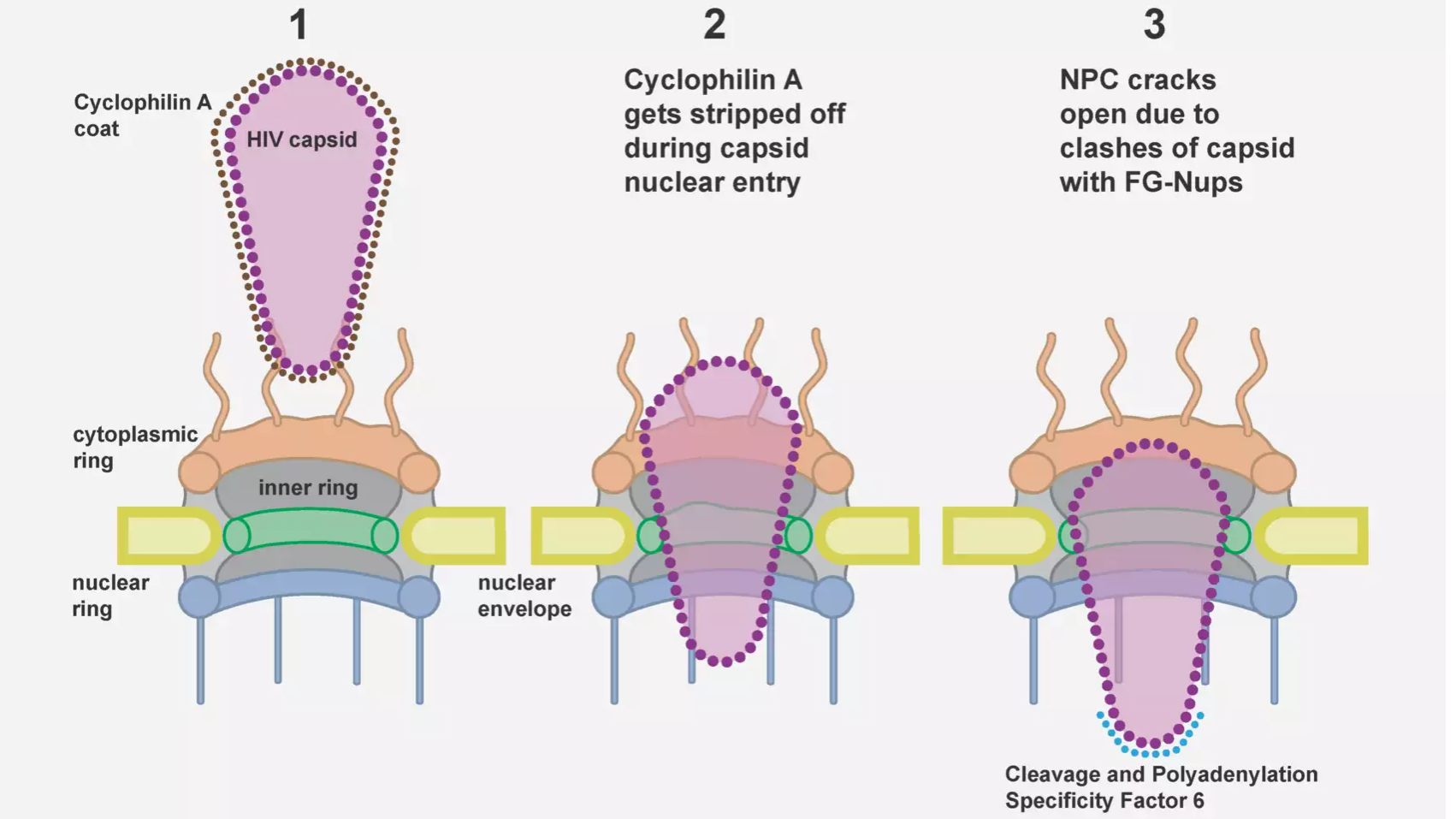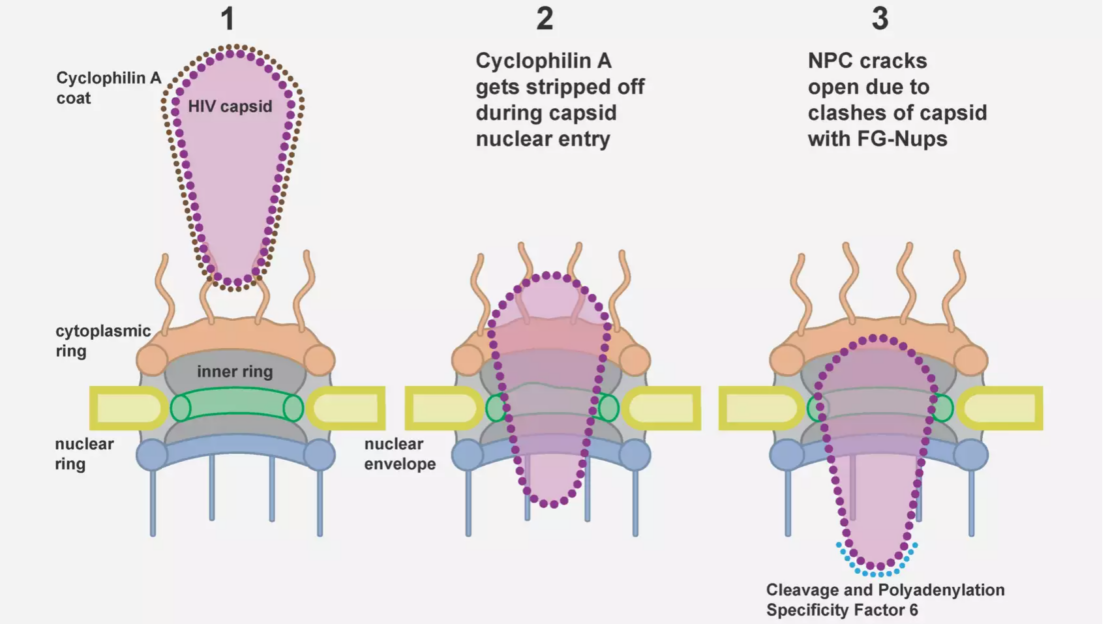How the HIV-1 Capsid Cracks the Barrier of the Human Nucleus

New evidence points towards a forceful entry of HIV-1 capsid into the nucleus of human cells
Researchers at the Max Planck Institute of Biophysics and Heidelberg University have observed largely intact HIV-1 capsids as they enter the cell nucleus through specialized channels called nuclear pores. In an exciting interdisciplinary study, they propose a new mechanism that protects the virus’ genetic information inside the capsid at the cost of the nuclear pore’s integrity.
Text: Pamela Ornelas/Stefanie Boehm
Human immunodeficiency virus type 1 (HIV-1) targets important cells of our immune system, making infected individuals more vulnerable to other infections. Once inside human cells, HIV transports the viral genome into the cell nucleus, where it is released and integrates into that of the human host. It cannot be removed afterwards, preventing cure of the infection. Subsequently, the virus uses our body’s machinery to produce copies of itself and spread infection. Over the past decades understanding and treating HIV infection has advanced tremendously. The new drug lenacapavir, which binds the HIV-1 capsid and blocks release of the viral genome, was found to effectively prevent HIV infection in clinical trials. Recently, it was thus granted FDA Breakthrough Therapy Designation and was named Breakthrough of the Year by the journal Science. However, while preventing infection and spread of HIV-1, lenacapavir cannot undo the integration of the virus’ genetic information into the human genome and thus offers no ‘cure’. Uncovering further details of its mechanism of action will be important for the ultimate goal of eradicating the virus.
The HIV-1 capsid plays key roles in the processes leading to release and integration of the viral genome. Similar to a soccer ball, the HIV-1 capsid is built from an arrangement of hexamers and pentamers. It is however not spherical, but shaped like a cone, with a narrow and a wider end. This capsule contains the viral genome as its payload. For successful infection, it has to ultimately open up to release the viral genetic information. In their new work, the groups of Martin Beck and Gerhard Hummer from the Max Planck Institute of Biophysics in Frankfurt and Hans-Georg Kräusslich from Heidelberg University combined high-resolution imaging with sophisticated computational simulations to study nuclear entry of HIV-1 capsids in infected human immune cells called macrophages.
How do capsids pass through a channel of similar width?

Nuclear pore complexes (NPC) are the guardians of the human genome that is packaged into the nucleus of all cells. They form selective channels through the envelope of the nucleus and connect its interior to the cytoplasm. Those channels are filled with specialized proteins called FG-nucleoporins, which act as gatekeepers. They control which molecules can enter the channel and which ones are kept outside of the nucleus. The invader needs to pass this barrier to deliver its payload into the nucleus. The HIV-1 capsid achieves this by mimicking the properties of human proteins that can pass the nuclear pore. It is therefore attracted to the channel instead of being excluded. However, the authors highlight that at its widest dimension, the capsid has a similar size as the NPC channel diameter. This fact supported earlier hypotheses that capsids dissolve and release their viral genetic material before reaching the nucleus. However, the evidence published in Cell by Kreysing, Heidari, Zila et al. indicates that the HIV-1 genome enters the nucleus largely intact, but alters the nuclear pore.
Using state-of-the-art high-resolution cellular tomography and super-resolved microscopy, the authors were able to observe HIV-1 capsids in different regions of infected primary human macrophages. They found that capsids had entered the nuclear pore channel with their narrow ends first, and pushed further and further towards the inside of the nucleus. Other than expected, the capsids did not show any signs of deformation or breakage inside of the nuclear pore channel. Instead, the researchers detected a significant number of nuclear pores that were cracked open once the broad end of the cone had pushed deeply inside the channel. The authors suggest that the entry of the capsid into the NPC generates a force that stretches the pore in its width until its ring-shaped structure cracks, similar to a nail that breaks its surrounding structure once driven forward. This crack widens the channel and allows the capsid’s progression into the nucleus. Computational simulations of the process support this hypothesis: the capsid could only pass through the NPC when the ring diameter was increased or if the ring cracked.
Towards a better understanding of HIV-1
Based on their discoveries, Kreysing, Heidari, Zila et al. propose detailed steps for HIV-1 capsid entry into the nucleus. These findings provide a potential explanation for the evolution of the unique HIV capsid structure: its conical shape might be necessary to enter into and break the NPC and to complete nuclear import of the viral genome.

According to Jan Philipp Kreysing, one of the first authors of this study, the work is important for HIV research as it elucidates the molecular details of a critical step during infection and provides new insight on the essential cellular gateway between cytoplasm and nucleus. The work also provides mechanistic insight on the already approved capsid-targeting drug lenacapavir and thus is a great example for the relevance of such basic research for drug development adds Hans-Georg Kräusslich. If cracking the nuclear pore provides the virus with a critical advantage, such as the delivery of a larger payload, remains an open question. Also, how the capsid ultimately opens up inside of the nucleus to release the viral genome has to be further investigated. Thus, understanding how HIV interacts with infected human cells will remain an active area of research.
In a nutshell: A research team from the Max Planck Institute of Biophysics and Heidelberg University, led by Martin Beck, Gerhard Hummer and Hans-Georg Kräusslich, has discovered a novel mechanism by which the HIV-1 capsid enters the nucleus of a human cell. They present surprising new evidence that the capsid cracks the channel it uses to enter the nucleus, the nuclear pore complex, while staying apparently intact itself. Their interdisciplinary study, published in the journal Cell, helps to explain the action of a capsid-targeting drug and could influence future design of HIV inhibitors as it shows that the capsid retains structural stability when it enters the nucleus.
Key findings:
- Cone-shaped HIV-1 capsids accumulate at and pass through nuclear pores in human immune cells such as macrophages.
- The conical shape of the capsid could facilitate transport through the nuclear pore.
- The capsid’s characteristic hexagonal lattice structure remains largely intact as it crosses the nuclear pore.
- Passage of the capsid generates a force that can crack the rings of the nuclear pore complex open.
Literatur
Kreysing JP, Heidari M, Zila V, et al. Passage of the HIV capsid cracks the nuclear pore. Cell. Published online January 17, 2025. doi:10.1016/j.cell.2024.12.008
Weitere Informationen im Internet
Pressemeldung des Max-Planck-Instituts für Biophysik, Frankfurt am Main
Abteilung Virologie, Teil des Zentrums für Infektiologie, Universitätsklinikum Heidelberg
Abteilung Molekulare Soziologie, MPI für Biophysik, Frankfurt
Pressemeldung des UKHD vom 10. Februar 2021: Neues Puzzleteil der HIV-Infektion erforscht: Virus-Capsid gelangt unversehrt in den Zellkern




